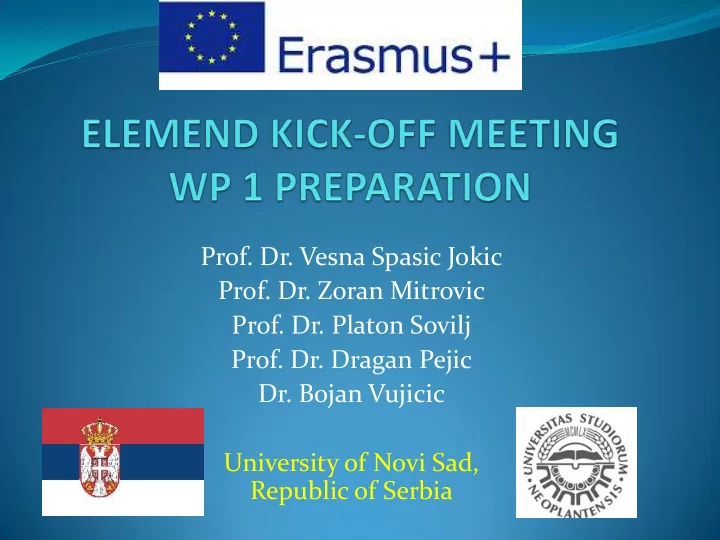

Prof. Dr. Vesna Spasic Jokic Prof. Dr. Zoran Mitrovic Prof. Dr. Platon Sovilj Prof. Dr. Dragan Pejic Dr. Bojan Vujicic University of Novi Sad, Republic of Serbia
WP 1 PREPARATION Analysis of existing curricula and study programmes in the field of smart grids and electricity markets in EU and Western Balkans HEIs Estimated Start Date: 01-11-2017 Estimated End Date: 01-05-2018
The aims of WP1 Map the existing situation in engineering education with respect to smart grids, ICT and electricity markets in the partner countries Analysis of existing curricula in smart grids at EU universities ( will be prepared by the EU partners).
The aims of WP1 (cont.) Review of stakeholders’ expectations or needs. (UNS will coordinate this task with the help of staff members from EU partners)
TASKS • ACT 1.1 Analysis of related courses/programmes and practices at EU universities • ACT 1.2 Review and SWOT analysis of existing WBC energy and ICT studies and market needs • ACT 1.3 Creation of the competence matrix based on the inputs from the labour market and industry • ACT 1.4. Creation of learning outcomes for both the updated BSc programmes and new MSc programme
Time frames • SWOT analysis base document sent to the WBC partner participants (December 20, 2017) • MATRIX ON COMPETENCE draft document sent to the WBC partner participants (December 20, 2017) • Analysis of existing energy and ICT studies in WBC HEIs (December 20, 2017) • Deadline for WBC participants contributions is 20 th February 2018.
• The Strengths, Weaknesses, Opportunities, and Threats (SWOT) Analysis reveals that deliberate changes must be made to facilitate institutional growth and development and meet the expectations of employer and student customers. • SWOT Analysis provides a nice baseline of the feedback received by employees and external stakeholders that concisely targets issues to address in the Strategic Plan and operationalizing of that Plan.
SWOT Analysis (cont.) The SWOT analysis was used to develop the attached strategic questions. These questions and others raised by participants at the workshop will help define strategic directions important to the university in next three years.
SWOT - Strengths What are your competitive advantages? What are your core competencies? Where are you making the most impact? What are you doing well? Employee commitment/engagement? Physical infrastructure? Employer support foundation? Sustainability initiatives/practices?
SWOT- Weaknesses What areas are we avoiding? Where do we lack resources? What are we doing poorly? Where are we losing reputation? What needs improvement? Rigorous academic programs? Data availability, integration and alignment?
SWOT- Weaknesses Communication and marketing? Lack of academic counseling? Business processes confusion? Education pathways barriers and transparency? Lack of strong, pervasive presence in the external community ? Limited resources for faculty and staff development? Highly competitive market for diverse faculty and staff?
SWOT- Opportunities Any beneficial trends? Niches that competitors are missing? New technologies? New needs of students/faculty/staff? Employer engagement/work based learning? Articulation options/ partnering with industry and research institutes? External image improvement?
SWOT- Opportunities Diversity of entering students? Data-informed student success? Partnerships in support of university initiatives? Expanded possibilities for the workforce ? Diversity of region (students – industry) ? External Community and University relationships- Interest in academic program expansion?
SWOT- Threats Obstacles to overcome? Competitors doing it better? Negative economic conditions? Vulnerabilities? State funding? Enrollment levels?
SWOT- Threats Perception and visibility of study programme? Increased higher education options in other areas? Reporting requirements absorb a large percentage of resources? Shift in focus on numerical achievement vs. qualitative achievement? Negative public perception?
MATRIX ON COMPETENCE In building the Matrix on competence it is necessary to include some basic facts: Who needs to be trained? Levels of training needs Competences of teacher and trainers Maintenance of Cycle of competent education
MATRIX ON COMPETENCE Cycle of competent education consists of: Identifying of Learning Needs; Setting Objectives; Choosing teaching and training techniques; Delivery of education and Evaluation.
The basic elements for building competence education 1) Carrying out a basic training needs analysis 2) Understanding the psychology of learning, the process of learning, learning styles, preferences, etc. 3) Structuring a learning event – lesson/session plans 4) Objective and outcome defining and writing
The basic elements for building competence education 5) Delivery skills: • Presentation skills • Facilitation skills • Demonstrations • Facilitating learning exercises and activities • Giving feedback • Managing questions • Managing behaviour in the training room • Using learning aids – flipcharts, models, videos etc. • Training room evaluation techniques
Electrical Energy Markets and Engineering Education Reducing the Bargaining Power of Suppliers Reducing the Threat of New Entrants Reducing the Competitive Rivalry between Existing Suppliers Reducing the Bargaining Power of Customers Reducing the Threat of Substitutes
Analysis of existing energy and ICT studies in WBC HEIs WBC participants are requested to include the following elements: • Course name • Level of study • Number of ECTS • Pre-examination and final examination obligations • The content of course • Goal and outcome • Preconditions • Other
CORE SUBJECTS and related study programs that will be subject of analyses 1. Electricity Markets 2. Energy Management 3. RES integration in smart grids 4. Energy storage 5. Electric vehicles and smart grids 6. Intelligent grid control 7. Smart grid technologies
CORE SUBJECTS and related study programs that will be subject of analyses 8. System modeling 9. Advanced optimization techniques in Energy systems 10. Energy efficiency techniques 11. IT Management with Enterprise Architecture 12. Wireless Communications and Networks 13. Power electronics in smart grids 14. Smart electrical networks and systems
Non university partners Competence matrix based on inputs from labour market and industry Learning outcomes for both the updates BSc and new MSc programmes Participation in First workshop
Posssible obstacles? Lack of coordination with administration Untimely submission of data by project participants The lack of interest of the stakeholders Bulky bureaucratic procedures
CONTACT Prof. Dr. Vesna Spasi ć -Joki ć email: svesna@uns.ac.rs THANK YOU!
Recommend
More recommend